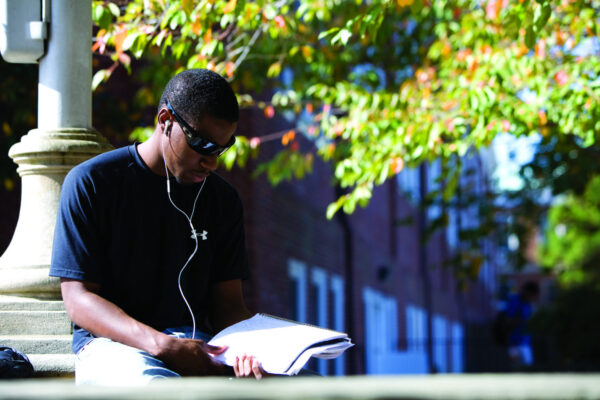Nance Roy, chief clinical officer of the Jed Foundation and assistant clinical professor at the Yale School of Medicine Department of Psychiatry, looks at steps colleges and universities can take to support student mental and emotional health.
This post is the latest in a series on college student mental health and well-being.
Young adulthood is a time of growth, learning, and exploration—a time to start building a life of your own and get excited about the future. Yet for some of our nation’s 21 million college students, the transition into adulthood is a time of significant change and intense challenge to their emotional health and well-being.
Recent survey data indicate that in the past year, three out of five students experienced overwhelming anxiety, and two out of five students were too depressed to function. Many students are struggling with mental health concerns like anxiety, depression, and substance abuse. But only a small percentage (10–15 percent on average) of these students seek services at their counseling center. Instead, they continue to struggle, which can have a substantial impact on their academic performance. This disconnect requires campuses to rethink their approach to supporting students with mental health concerns, as for some, early intervention may avert the need for professional help.
Action steps to support emotional well-being, reduce suicide, and reduce substance abuse
To foster a community of support, campus administration should consider a comprehensive public health approach that promotes emotional well-being, with the goal of reducing suicide and substance abuse on their campuses.
Two guiding principles form the foundation for effecting enduring, systemic change toward this end. First, support for emotional well-being and reduction of suicide and substance abuse must be considered a campus-wide responsibility. Second, it is imperative that senior leadership acknowledge the importance of student mental health and well-being and make this a shared value for the entire campus community.
With these guiding principles in place, faculty, staff, and administration are better positioned to develop a culture of caring and compassion where students feel supported. Some action steps to consider to create that culture include:
Teaching life skills: Supporting life-skills education for students is valuable in teaching healthy ways to cope with the stress of college life. Among the life skills that are important to a student’s well-being are managing friendships and relationships; problem-solving; decision-making; identifying and managing emotions; healthy living; and finding life purpose, meaning, and identity.
For example, Northwestern University (IL) developed an app for students, called “Breathe,” to support healthy living and manage stress. It provides a variety of guided meditations and breathing practices to help deal with stress; reduce the negative impact on mind, body, and spirit; decrease perfectionism and self-criticism; and enhance confidence and well-being.
Promoting social connectedness: Research has shown that loneliness and isolation are significant risk factors for mental health problems and suicidal behavior. Supportive social relationships and feeling connected to campus, family, and friends are protective factors that can help lower risk.
One example of a campus community coming together to promote connection is Massachusetts Institute of Technology’s (MIT) Random Acts of Kindness week (RAC), part of their MindHandHeart initiative. RAC is a weeklong series of events aimed at helping people connect through small acts of kindness, such as handing out flowers to people and pinning encouraging phrases on students’ backpacks. MIT Libraries provide stationary, postage, and paper so students can write a letter to someone, and they send it for them anywhere in the world. One course gave each student five dollars in their campus cash accounts to “spend on something for someone else.”
Identifying students at risk: It is important to identify students at risk for mental health problems and suicidal behavior and also to promote emotional health awareness among those who interact with students the most: the gatekeepers, such as residence hall staff, academic advisors, faculty, and even fellow students. It also is vital for these people to be able to recognize and refer a student who might be in distress.
One example of an innovative program is called I CARE at the University of Pennsylvania. I CARE is an interactive gatekeeper training for students, faculty, and staff that builds a caring community with the skills and resources needed to intervene with student stress, distress, and crisis. The initiative includes information, discussion, and experiential exercises that focus on understanding mental health beliefs and biases, engaging in self-care, and other relevant areas.
Encouraging help-seeking: Some students who need help may be reluctant or unsure of how to seek it out. Obstacles to help-seeking include lack of awareness of mental health services, skepticism about the effectiveness of treatment, prejudices associated with mental illness, and uncertainty about costs or insurance coverage.
Campuses should consider activities designed to increase the likelihood that a student in need will seek help, such as faculty at Santa Clara University (CA) are doing. For example, Chan Thai, a professor from the Department of Communication, uses class assignments to have students develop stigma-reduction campaigns and increase help-seeking behavior. The course teaches students how to develop a strategic campaign plan, implement the campaign, and evaluate the effectiveness of the campaign.
Providing mental health and substance use services: It is essential to offer accessible, consistent, and high-quality mental health services to students. This strategy should be comprehensive and include strong and flexible services; adequate staffing levels and staff diversity reflective of the student population; flexibility in treatment approaches; and clinic hours that are reflective of student schedules. Since most college clinics are free, the length of treatment is often limited. So it’s important that campus mental health services can help students find off-campus resources that can provide long-term care if needed.
One approach to providing mental health and substance use services in a flexible and integrated way is modeled by the University of Nevada, Las Vegas (UNLV). This institution has an integrated wellness center that facilitates communication between health and counseling services. The integration of these services enables UNLV to provide comprehensive, holistic care to their student body.
Following crisis management procedures: The campus should have access to a well-publicized, 24/7 crisis phone and/or chat line either through campus resources or local or national services. There should be a process in place to share information (as legally appropriate) between local hospitals and school health and counseling services.
The University of California, Davis has implemented services to help students in crisis. The institution has contracted with Crisis Text Line (CTL) to provide students with immediate mental health support and increase help-seeking behavior. With the CTL launch, they developed a toolkit and web page which was shared and adopted on campuses across the UC system. This toolkit and web page provide resources for campus community members to spread awareness and information about CTL. In addition, all student ID cards include CTL information so that the resource is readily available for students who may be in crisis.
Restricting access to potentially lethal means: It has been well established that removing or limiting access to means for self-harm can prevent suicide and even limit accidental deaths. This is called “means restriction.” Limiting students’ access to weapons, poisonous chemicals, and rooftops, windows, or other high places are all means-restriction activities. Each campus should do an environmental scan for potential access to lethal or dangerous means.
Cornell University (NY) has identified and restricted access to areas around campus that have been sites for self-harm. The institution installed nets under three city-owned bridges as a means restriction/suicide prevention measure. They have also conducted a campus environmental scan to identify and secure potentially dangerous areas on campus where students could bring harm to themselves or others.
Guided by this comprehensive framework, colleges and universities will be well positioned to support the emotional health of their college students and the environments that hold them. By incorporating a holistic approach, institutions can better promote their students’ ability to flourish—socially, emotionally, and academically.
All of the suggested action steps above are from JED’s Comprehensive Mental Health Promotion and Suicide Prevention for Colleges and Universities. Specifically, the JED Campus program is designed to guide institutions through a collaborative process of comprehensive systems, program, and policy development with customized support to build upon existing student mental health, substance abuse, and suicide prevention efforts.
A link to a full description of the JED Campus program, as well as a brief video outlining the program can be found here:
https://www.jedcampus.org
https://www.youtube.com/watch?v=fp_l8_fAN9k
If you have any questions or comments about this blog post, please contact us.


